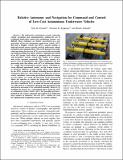| dc.contributor.author | Fischell, Erin Marie | |
| dc.contributor.author | Rypkema, Nicholas Rahardiyan | |
| dc.contributor.author | Schmidt, Henrik | |
| dc.date.accessioned | 2021-10-27T19:57:39Z | |
| dc.date.available | 2021-10-27T19:57:39Z | |
| dc.date.issued | 2019 | |
| dc.identifier.uri | https://hdl.handle.net/1721.1/134016 | |
| dc.description.abstract | © 2016 IEEE. The underwater environment severely constrains robotic navigation and communications, making the use of traditional multi-robot control and coordination schemes very difficult. These challenges are exacerbated on a new generation of low-cost autonomous underwater vehicles (AUVs) that lack a Doppler velocity log, acoustic modem, or high-end inertial sensors typically used for underwater robotic navigation and communications.This letter demonstrates multi-robot operations for low-cost AUVs via a novel and user-friendly operating paradigm that allows intuitive command and control of an AUV group. Each vehicle is equipped with a low-power and inexpensive acoustic system for navigation and receipt of operator commands. This system consists of a passive array of hydrophones and a timed acquisition and data processing stack that allows each AUV to self-localize relative to a time-synchronized acoustic beacon. Switching between different operational 'modes' on the beacon causes it to broadcast different acoustic signals which, when received by the AUVs, result in the vehicles switching between different autonomous behaviors. These behaviors are defined in a beacon-centric coordinate system using pre-defined parameters unique to each vehicle; as a result, the movement of the beacon itself allows the operator to control the group-wide movement of all vehicles concurrently. This letter presents field experiments with three SandShark AUVs in which operational mode and beacon movement were controlled by an operator. However, by installing the beacon on an autonomous vehicle, this paradigm would provide a method for remote command and control of an arbitrarily large number of miniature, low-cost AUVs, without the need for sophisticated navigational sensors or acoustic modems. | |
| dc.language.iso | en | |
| dc.publisher | Institute of Electrical and Electronics Engineers (IEEE) | |
| dc.relation.isversionof | 10.1109/LRA.2019.2896964 | |
| dc.rights | Creative Commons Attribution-Noncommercial-Share Alike | |
| dc.rights.uri | http://creativecommons.org/licenses/by-nc-sa/4.0/ | |
| dc.source | MIT web domain | |
| dc.title | Relative Autonomy and Navigation for Command and Control of Low-Cost Autonomous Underwater Vehicles | |
| dc.type | Article | |
| dc.contributor.department | Joint Program in Applied Ocean Physics and Engineering | |
| dc.contributor.department | Woods Hole Oceanographic Institution | |
| dc.contributor.department | Massachusetts Institute of Technology. Department of Electrical Engineering and Computer Science | |
| dc.contributor.department | Massachusetts Institute of Technology. Department of Mechanical Engineering | |
| dc.relation.journal | IEEE Robotics and Automation Letters | |
| dc.eprint.version | Author's final manuscript | |
| dc.type.uri | http://purl.org/eprint/type/JournalArticle | |
| eprint.status | http://purl.org/eprint/status/PeerReviewed | |
| dc.date.updated | 2020-08-17T14:27:00Z | |
| dspace.orderedauthors | Fischell, EM; Rypkema, NR; Schmidt, H | |
| dspace.date.submission | 2020-08-17T14:27:03Z | |
| mit.journal.volume | 4 | |
| mit.journal.issue | 2 | |
| mit.license | OPEN_ACCESS_POLICY | |
| mit.metadata.status | Authority Work and Publication Information Needed | |
